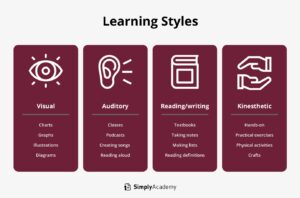A guide to discovering your learning style
27 August 2024

If you’ve ever wondered why some subjects may come easy to you but have struggled with others, the answer could be linked to your learning style. For this reason, understanding how you best absorb information can not only help you with your studies but also actually help when it comes to career progression.
You may be a visual learner who enjoys learning through diagrams and charts, or perhaps you’re an auditory learner who prefers lectures and discussions. If you’re a kinesthetic learner, you may like hands-on experiences. It’s also possible that you have a combination of learning styles.
Tailoring your study habits and learning environment to match your strengths can help improve your focus and retention, and make the learning process more enjoyable. Whether you’re a student, a professional looking to upskill through one of our Simply Academy online courses, or just curious about how you learn, this guide will help you discover your learning style.
What are the four learning styles?
Learning styles aim to identify how people learn best, and while there are many ways of categorising them, Neil Fleming’s VARK model is widely recognised in psychology and education. According to this model, there are four learning styles; visual, auditory, reading/writing, and kinesthetic. Let’s take a closer look at each of these.
Visual
Visual learners thrive on seeing information presented in a clear, concise way. They excel when information is displayed in charts, graphs, or illustrations. Those who prefer this learning method find it easier to remember concepts when they can visualise them. Additionally, observing body language can significantly improve their comprehension and retention. Incorporating pictures and diagrams into study materials is highly beneficial for visual learners.
Auditory
Processing information through sound is best for auditory learners. Lectures and classes are a prime learning environment for them as they retain information effectively when it’s spoken. Participating in class discussions can solidify their understanding and when studying, creating songs and reading aloud can be helpful. Audio resources such as podcasts can help them when studying
Reading/writing
Reading and writing are essential for those who prefer textual information. These learners find it best when words and written materials are displayed. Reading and writing learners enjoy making lists, creating presentations, and reading definitions. Textbooks, handouts and taking notes in class help them when learning and allow them to digest information easily.
Kinesthetic
Kinesthetic learners enjoy learning through practical tasks like cooking, painting, or sports. Experiential learning is key for them, as they take in information best by doing things physically. These learners often find it challenging to sit still for extended periods. Classes incorporating practical elements are ideal for kinesthetic learners to understand new skills effectively.
How your learning style can help you choose an online course
Understanding your learning style can significantly influence your choice of an online course and enhance your learning experience. Reviewing the course syllabus and delivery methods is important to ensure they align with your learning preferences. Look for various content formats and teaching approaches that cater to the different learning styles. For example, our mortgage advisor courses offer a classroom setting, a virtual classroom to combine the classroom setting with a location of your choice, or a self-study option.
Visual learners should seek courses with plenty of diagrams, charts, videos, and visual presentations. Courses that offer audio lectures, podcasts, and discussion forums are great for auditory learners. Reading/writing learners should look for courses with comprehensive written materials, transcripts, and opportunities for written assignments. Kinesthetic learners should opt for courses with hands-on activities or practical exercises.
Some online courses offer adaptive learning technologies that adjust to your progress and preferences. This can be particularly beneficial if you have a mixed learning style.
Remember that while catering to your preferred learning style can be helpful, it’s also useful to challenge yourself by exploring different learning methods.
The benefits of knowing your learning style
Knowing your learning style offers several benefits that can improve your educational and professional experiences. Here are some of the benefits:
- It can help you learn faster. You’re more likely to pay attention and absorb information quickly when engaged in activities that match your learning style, allowing you to focus your attention.
- It can help you retain information better. Using study techniques suited to your learning style can improve your ability to recall information when needed, as information processed effectively is more likely to be stored in long-term memory.
- Improve your overall motivation. Understanding your learning style and applying it can help boost your confidence. Knowing which method appeals to you makes studying a new subject or learning a new skill more enjoyable and makes the process less daunting.
- It can help you develop more effective study strategies. Knowing your learning style allows you to tailor your approach to studying and will enable you to choose study methods that cater to your strengths. It also helps you create a study space that suits your needs such as a quiet study area for auditory learners.
Leverage your learning style for career success
The benefits of knowing your learning style don’t just end with the studying process, they can also significantly impact your career success. Understanding how you process information best can help you select roles and work environments that align with your preferred style. For example, visual learners might excel in design or marketing, while auditory learners could thrive in customer service or sales.
Knowing your learning style can help you develop effective time management strategies, tackle challenges creatively, and communicate ideas to colleagues with different preferences, helping you build strong relationships. Aligning your career path with your learning style can increase job satisfaction, productivity, and overall professional fulfilment.
Learning styles should not be the sole factor in selecting a career path. Regardless of the job you pursue, being aware of your learning style can help you discover the most effective methods for acquiring new skills, advancing your career, adapting to new environments, and supporting the growth of others.




